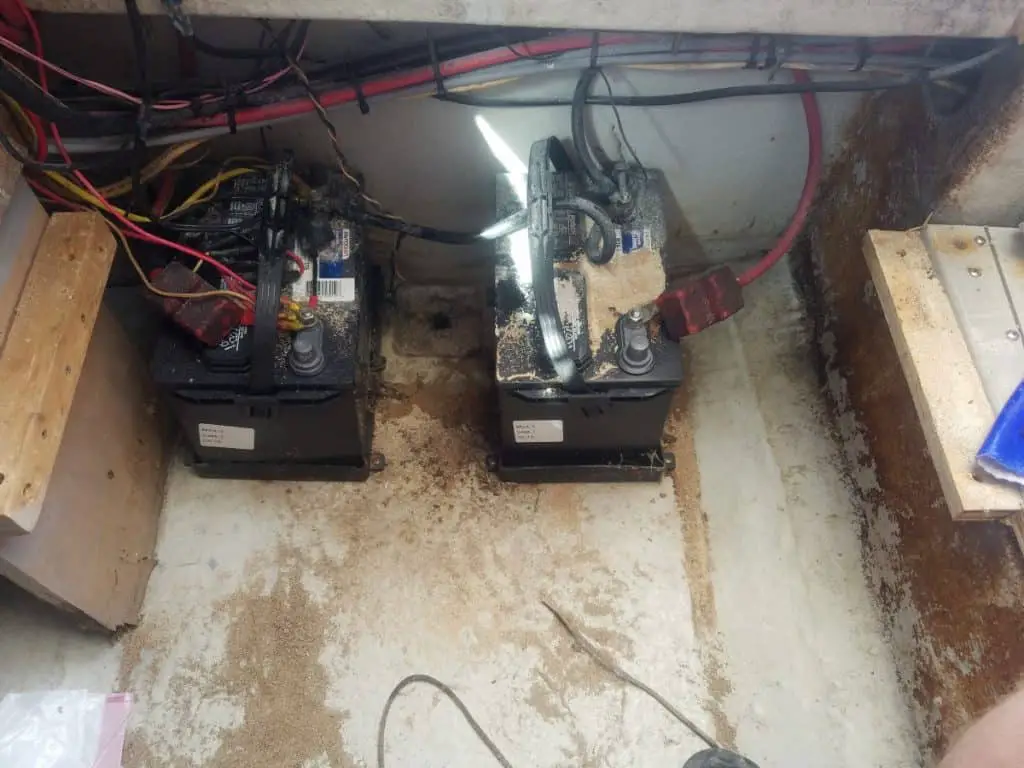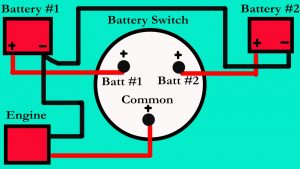Being on a boat is a lot different from being on land. On land, you have plenty of electricity. And access to it almost anywhere! On the other hand, on a boat, electricity is a fine commodity! This reason is why you want to make sure that you have plenty of it!
How Many Batteries Should I Have On My Boat?
- Boats under 14 feet will only require one battery.
- Boats 15-23 feet, with a single-engine, will only require two batteries unless they have a trolling motor, which can require up to three more batteries.
- Boats 24 feet and up, with more than one engine will require three or more batteries with an additional battery for every additional engine. As well as additional house batteries, depending on the electronics equipment that is in the boat.
There are so many variables for determining how many batteries your boat should have. Here are all the things that you will need to consider to determine this!
How Many Cold Cranking Amps Do I Need For My Boat?
The bigger your boat engine is, the more power it requires to turn over and start. To select a suitable battery for your boat, you need to know how much current your boat engine requires to start.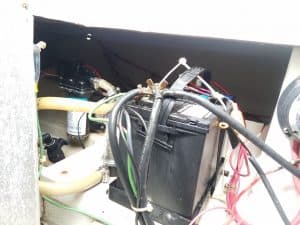
The cold-cranking amps are a measure of how many amps of current a certain battery can deliver in 30 seconds at 0o F without going under the voltage specifications. Depending on the type of battery you have, the voltage specification is usually around 9.5 to 10.5 Volts.
To determine how many cold cranking amps your boat engine requires, you can check the specifications for your exact engine model. Or you will have to take current measurements from the engine. For this, you will need a piece of equipment called a clamp meter.
Connect the clamp of your clamp meter to the high voltage lead on your starter to know exactly how many amps it is receiving.
If you do not have a clamp meter in your garage, do not worry. You can borrow one from someone in your local marina, or your local boat mechanic.
Alternatively, if you would like to add one to your inventory for future use, you can buy one from Amazon. You can find a good quality clamp meter here.
After you determine the number of amps your boat engine requires to start, select a suitable battery that can deliver that amount of power. With a powerful enough battery, you will never have to worry about turning the ignition to find that your engine does not start.
You might want to read this article we have written here: For the Steps To Take if Your Engine Won’t Turn Over!
How Many Batteries Are Normally In A Boat?
Every boat has two types of power requirements. One is the starting load, which is the amount of power your boat requires to start up. The other is the running load, which is the amount of electrical power your boat requires in its running state.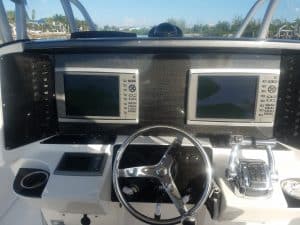
The different electronics on your boat, such as the GPS, the motor for your trim tabs, and any lighting you might have on board.
Traditionally, all boats have at least two different types of batteries. One is the starting battery, which you use to start the engine. The other is what is called a house battery, which is responsible for powering all of your lights and electronics.
Starting Battery
Starting batteries need to deliver large amounts of current (often between 75 to 400 Amperes) to start your boat’s engine. They can only provide this huge amount of current for a short time (less than 15 seconds).
Using your starting battery for longer than this can cause irreversible damage to the battery. Thus, if you crank and crank and crank on your battery when your engine won’t start. You can wear the battery out.
Starting batteries do have an “estimated” lifespan. Basically, there is an “estimated” number of “starts” you can put the battery through. Or what would be called a discharge cycle.
Where the battery is used by starting an engine. This puts that massive draw on the battery and drains a large amount of power. When the battery is new. It can carry a longer load or discharge cycle.
Once the engine is running, it begins charging the battery back up. So the battery never really goes to a fully discharged state. Which makes the “lifespan” last longer.
Now if your engine is not charging that is another thing altogether. And you can learn all about Outboards Having Stators & Alternators That Charge Your Batteries & How That Works. By reading that article there.
Deep Cycle Battery
The other type of battery in popular use is the deep cycle battery. As the name implies, these types of batteries can easily withstand deep discharge cycles without compromising on their lifespan.
Due to this feature, boaters usually use a deep cycle battery for powering all the electronics, lights, and pumps on their boats.
You can think of deep cycle batteries as the built-in battery bank of your boat that is responsible for storing and providing electrical energy as needed. You can charge them up on shore, and take the electrical power with you when you set out on the water.
You can also recharge your deep cycle battery while out on the water. Normally, your batteries are connected to your engine’s alternator to keep your deep-cycle battery charged up.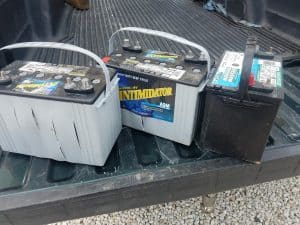
Alternatively, you can use renewable sources of energy such as solar panels or wind turbines to charge your deep cycle battery while on the water as well.
When selecting a suitable deep cycle battery for your boat, it is a good idea to get one that is capable of storing much more power than what is usually required on your offshore trips.
Basically, the bigger the better when you need a lot of power! Most boats consuming a lot of power will use either a group 27 or group 31 AGM battery.
Do I Need Two Batteries for My Boat
Many boats use a starting battery and a house battery in conjunction to power all the electrical loads out on the water.
However, keeping two heavy and bulky batteries on your boat is not always feasible, especially if your boat is too small. For these situations, there is an alternative solution to your needs of electrical power on the water:
Dual-Purpose Batteries
As the name suggests, dual-purpose batteries are capable of powering your starting as well as your electronics. These batteries include active lead paste chemistry and thicker and larger plates that contain more antimony than other types of batteries.
The construction of these batteries allows them to undergo deep discharge cycles that other starting batteries simply don’t handle well. Thus, you can use them to start your boat engine AND power all your electronics.
The drawback to dual-purpose batteries is that they are generally more expensive than either starting or deep-cycle batteries. They also have lower power capacity than a similarly sized deep cycle battery.
However, despite the drawbacks of dual-purpose batteries, they offer an extremely valuable power solution for certain applications. If you have a small powerboat like a runabout, space is of primary concern.
You can use a dual-purpose battery in your boat instead of two different batteries to save space. Alternatively, you can have two different dual-purpose batteries on your boat and use them interchangeably as you recharge the other one. After using it all day!
How to Hook Up Dual Batteries in a Boat
Sometimes, there is such a huge power requirement on your boat that you simply cannot fulfill it with just one battery. You have to connect two or more batteries instead to sufficiently power the boat. You usually come across this issue with bigger boats that have more than one engine or lots of electronics.
Connecting two or more batteries to your boat engine(s) is simpler than it sounds. The procedure is the same for connecting two batteries, or three, or more. You just have to follow these simple steps.
- Secure all batteries on your boat.
- Take a heavy gauge wire like a 4 or 2 GA, and bridge all of the negative terminals of the batteries together.
- Install the switch in a suitable location, and then connect each positive terminals of the batteries to the switch. One positive to terminal 1 and one positive to terminal 2. Make sure that the switch is in the off position.
- Take a wire, and connect the output of the switch to the positive terminal of your engine.
- Use another wire to connect the negative terminal of your engine to the negative terminal of any of the batteries. (Picking the closest one to your engine would save you a lot of cable clutter).
There, you are done! It is really just as simple as that.
Marine Dual Battery Switch & System Wiring Diagram:
How Long Will A Boat Battery Last?
Your boat battery can last you a long time provided that you take good care of it.
Just make sure your boat does not have active loads when you are not using them to extend the life of your battery. You can read this article to find out all about taking proper care of your battery.
As well as this article here on How To Make Your Boat Batteries Last Longer!
What about Trolling Motors
If you have a trolling motor on your boat, you will require usually two to three deep-cycle batteries to power it. Unlike gasoline-powered engines, trolling motors run on stored battery power.
To keep your boat running throughout your adventure on the water, you need to buy those deep-cycle batteries with a large enough storage capacity.
And have the trolling motor wired up separately on its own circuit.
Check Us Out!
Now that you know all about how many batteries should be in your boat! Here are some more articles from us that you will find super helpful and informational!
How Long Do Boat Batteries Last? And How to Make Them Last Longer!
Can Boat Batteries Get Wet or Freeze?
Do Outboards Have Alternators & Charge Batteries?
We’d also like to invite you to check us out on Our YouTube Channel! Where we create all kinds of How-To and DIY boating projects to help you learn more and more about your boat and how it works!

